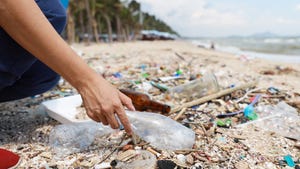Self-healing elastomers stop microcracks
A rubber tree has inspired researchers to develop a class of self-healing elastomers that can repair themselves autonomously. Researchers at the Fraunhofer Institute for Environmental, Safety and Energy Technology (UMSICHT; Oberhausen, Germany) loaded microcapsules with a one-component adhesive of polyisobutylene and placed it inside elastomers made from synthetic rubber. The result is plastics that stop the growth of microcracks that can propagate and lead to spontaneous material failure.
March 3, 2011
A rubber tree has inspired researchers to develop a class of self-healing elastomers that can repair themselves autonomously. Researchers at the Fraunhofer Institute for Environmental, Safety and Energy Technology (UMSICHT; Oberhausen, Germany) loaded microcapsules with a one-component adhesive of polyisobutylene and placed it inside elastomers made from synthetic rubber. The result is plastics that stop the growth of microcracks that can propagate and lead to spontaneous material failure.
Fraunhofer self healing elastomer. |
Over 30 minutes, the microcrack in the self-healing elastomer starts sealing. |
In the rubber tree and other plants that produce latex, such as the Weeping Benjamin, the latex contains capsules filled with the protein hevein. If the tree is damaged, latex is emitted and the capsules break open to release the protein, which acts to bond the latex and heal the wound.
Fraunhofer researcher Anke Nellesen said that in the polymer version they produced, if pressure is put on the capsules, they break open and separate this viscous material, which then mixes with the elastomers' polymer chains and closes the cracks.
Nellesen said her team achieved better results by putting the polyisobutylene self-healing component into the elastomer in a non-encapsulated format. Testing of different synthetic rubbers indicated "clear self-healing properties," with a restored tension expansion of 40% after a healing period of 24 hours.
The technology was further improved by charging the elastomers with ions, which ensured that the wound closure would remain stable, as the healing process can take place as often as needed. In the rubber tree, the hevein proteins that are released when there is damage link up to each other through ions and remain connected in this process so that the crack closes. Likewise, by charging the elastomers, if the material is damaged, the particles with opposite charges will find new bonding partners.
A self-repairing muffler suspension featuring the technology will be on display at the Hannover Fair (Hannover, Germany; April 4-8) at the joint Biokon/Fraunhofer stand in Hall 2. —PlasticsToday Staff
About the Author(s)
You May Also Like



